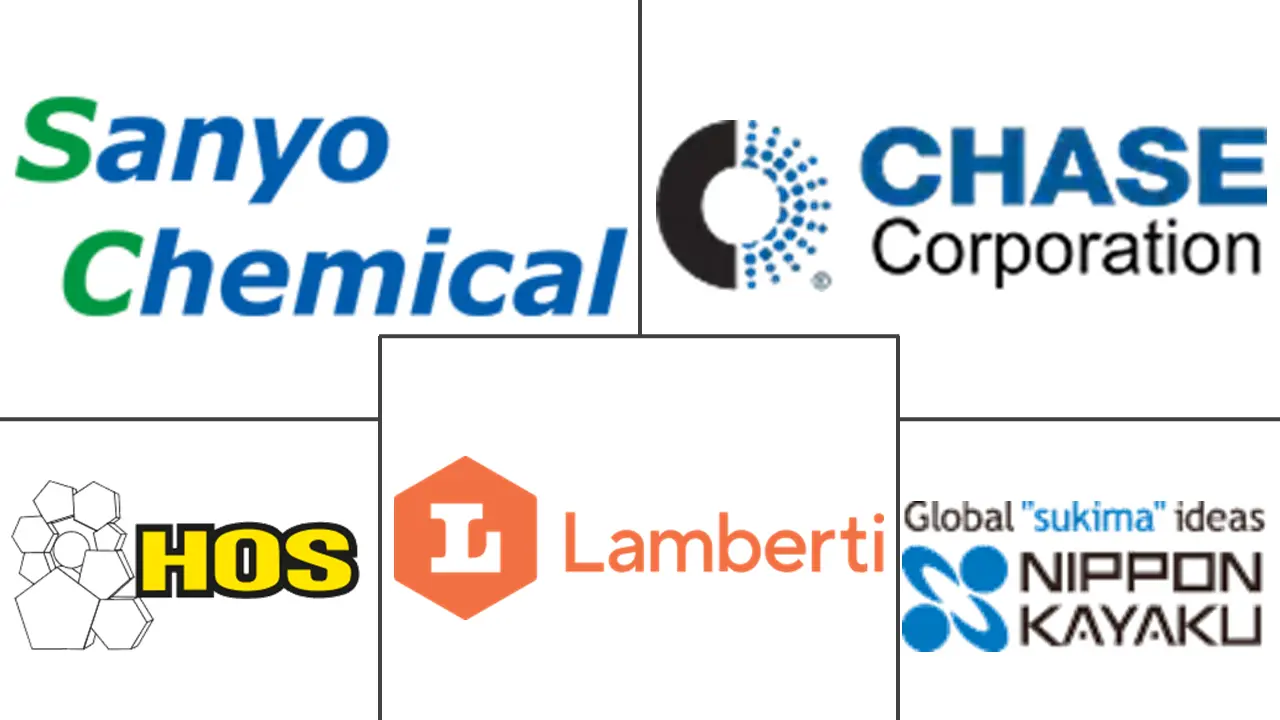Polyurethane Microspheres Market Size and Share
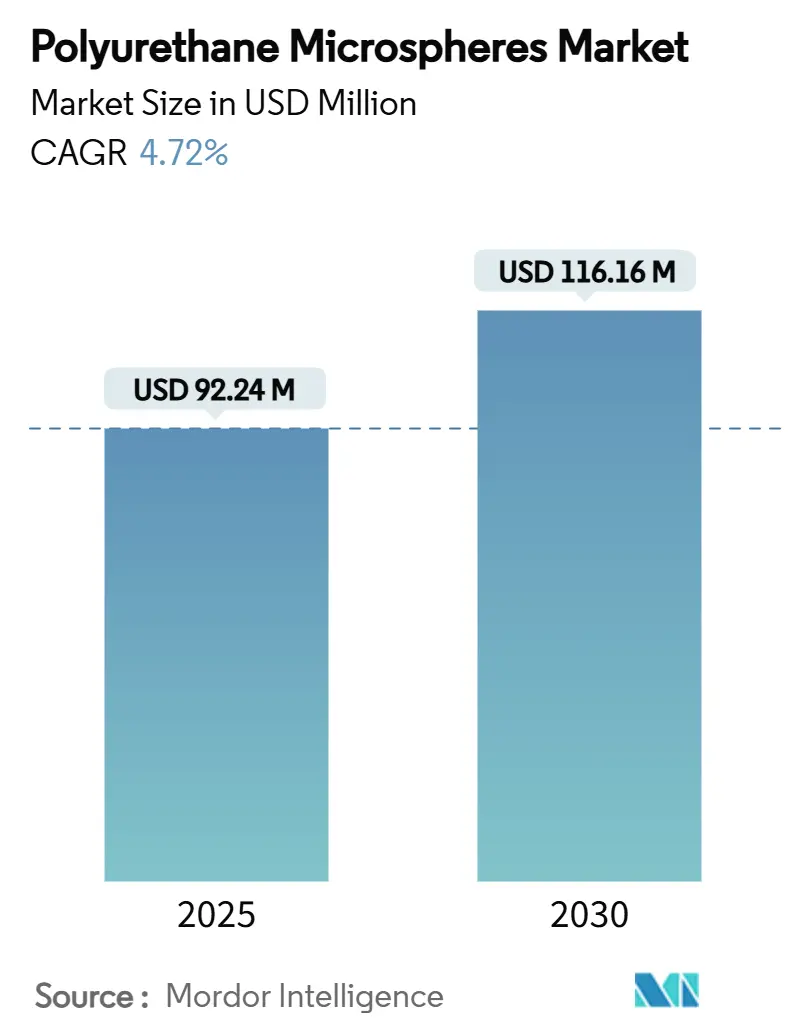
Polyurethane Microspheres Market Analysis by Mordor Intelligence
The Polyurethane Microspheres Market size is estimated at USD 92.24 million in 2025, and is expected to reach USD 116.16 million by 2030, at a CAGR of 4.72% during the forecast period (2025-2030). Demand is concentrated in high-performance sectors that value functional attributes such as weight reduction, thermal insulation and controlled release over sheer volume, allowing producers to defend premium pricing. Asia-Pacific supplies almost half of global volumes thanks to integrated supply chains and a dense electronics manufacturing base that accelerates product qualification cycles. Hollow variants dominate because they can cut coating density by up to 46% without sacrificing mechanical strength. At the same time, expandable grades are climbing fastest as 3-D printing, automotive and construction users search for lightweight foamed structures. Regulatory moves-—notably the EU REACH rule mandating training for workers handling products with more than 0.1% diisocyanate—are steering R&D budgets toward low-emission and bio-based chemistries.
Key Report Takeaways
- By microsphere type, hollow microspheres led with 46.54% of the polyurethane microspheres market share in 2024, while expandable microspheres recorded the highest projected CAGR at 5.02% between 2025 and 2030.
- By raw material, aromatic polyurethane maintained 60.45% share in 2024; aliphatic polyurethane is set to expand at a 5.17% CAGR through 2030.
- By application, paints and coatings held 35.61% of the polyurethane microspheres market size in 2024, whereas encapsulation applications are poised for the fastest 4.98% CAGR to 2030.
- By end-use industry, automotive dominated with a 28.82% revenue share in 2024, while electronics is projected to be the fastest-growing segment at 5.24% CAGR through 2030.
- By geography, Asia-Pacific accounted for 45.62% of the polyurethane microspheres market in 2024 and is forecast to post the highest regional CAGR of 4.88% during 2025-2030.
Global Polyurethane Microspheres Market Trends and Insights
Drivers Impact Analysis
| Driver | (~) % Impact on CAGR Forecast | Geographic Relevance | Impact Timeline |
|---|---|---|---|
| Rising demand from paints and coatings | +1.20% | Global, with strong growth in APAC and North America | Medium term (2-4 years) |
| Surge in high-performance micro-encapsulation for pharma and agrochemicals | +0.80% | Global, concentrated in developed markets | Long term (≥ 4 years) |
| Growth of 3-D printing inks and UV-curable coatings | +0.60% | North America & EU, expanding to APAC | Medium term (2-4 years) |
| Expansion in reactive hot-melt electronics adhesives | +0.40% | APAC core, spill-over to North America | Short term (≤ 2 years) |
| Integration in fragrance micro-capsules for detergents | +0.30% | Global, with premium market focus | Long term (≥ 4 years) |
| Source: Mordor Intelligence | |||
Rising Demand from Paints and Coatings
Automotive, industrial and architectural coaters deploy hollow polyurethane microspheres to cut wet-film weight by up to 46% while maintaining mechanical resilience. U.S. automakers alone consumed 142 million lb of polyurethane coatings in 2023, split almost evenly between OEM and refinish operations. Regulatory caps on VOCs are directing formulators toward waterborne and UV-curable binders that pair effectively with microspheres for reduced solvent demand. Thermal-insulation coatings incorporating the spheres deliver 45.2% lower thermal conductivity and lift tensile strength from 14.16 to 22.14 MPa, a key selling point for energy-efficient buildings. Nouryon’s 2024 launch of partially bio-based Expancel BIO grades aligns with OEM sustainability pledges while preserving recovery performance under 350 bar spray pressure.
Surge in High-Performance Micro-Encapsulation for Pharma and Agrochemicals
Polyurethane microspheres enable oral, injectable and transdermal drug products that modulate release kinetics, boosting patient adherence and minimizing side effects. Emulsion and polycondensation routes permit insertion of targeting ligands, while AI-driven formulation tools streamline excipient selection for precise payload delivery. In agrochemicals, encapsulated actives reduce runoff and volatilization, extending field efficacy windows and curbing environmental impact. Bio-based diisocyanates from D-galactose promise to eliminate phosgene, advancing green-chemistry credentials without compromising shell strength. Resulting demand underpins a rising premium niche within the polyurethane microspheres market.
Growth of 3-D Printing Inks and UV-Curable Coatings
Additive-manufacturing platforms such as digital light processing rely on UV-curable polyurethane oligomers that reach tensile strengths of 36.8 MPa and Shore hardness 91 in complex lattice parts. Hyperbranched waterborne systems achieve 80% C=C conversion in 50 s while preserving water resistance, enabling on-demand label and package graphics that comply with VOC limits. Rubber-seed-oil acrylates lower critical exposure energy to 15.2 mJ cm², enhancing print throughput versus petro sources. Expandable microspheres add foamed internal structures that cut part weight yet retain dimensional accuracy, a key advantage for footwear midsoles and drone casings. These performance gains sustain a robust, high-margin corridor within the polyurethane microspheres market.
Integration in Fragrance Micro-Capsules for Detergents
Consumer brands embed polyurethane/urea capsules with up to 73% fragrance payload that withstand spray-dry temperatures yet release aroma on fabric friction. Multi-stimuli shells that burst under UVA or humidity cues deliver premium sensory experiences in detergents and apparel, generating brand-differentiation premiums. The technology safeguards volatile oils, lowers dosage and reduces packaging footprint, boosting sustainability metrics. Detergent formulators therefore represent a steadily expanding niche buyer group inside the polyurethane microspheres market.
Restraints Impact Analysis
| Restraint | (~) % Impact on CAGR Forecast | Geographic Relevance | Impact Timeline |
|---|---|---|---|
| High production and processing costs | -0.90% | Global, particularly affecting smaller manufacturers | Short term (≤ 2 years) |
| Volatility in MDI and polyol prices | -0.50% | Global, with regional variations in supply chains | Medium term (2-4 years) |
| Stringent emission regulations on di-isocyanates | -0.70% | Global, with EU leading through REACH, followed by North America and expanding to APAC | Medium term (2-4 years) |
| Source: Mordor Intelligence | |||
High Production and Processing Costs
Suspension and interfacial polymerization lines require explosion-proof reactors, precise temperature control and advanced QA instruments, pushing capex beyond the reach of many SMEs[1]U.S. Environmental Protection Agency, “Methylene Diphenyl Diisocyanate (MDI) Action Plan,” epa.gov. REACH now obliges retraining every five years for any job role exposed to greater than or equal to 0.1% diisocyanate, further lifting overheads. Micro-emission hot-melts containing less than 0.1% free isocyanate mitigate the regulatory load but demand extra R&D and reformulation effort. Pharmaceutical-grade spheres pass through cGMP audits and extractables testing that inflate unit costs, whereas bio-based feedstocks still price above petro equivalents due to scale limits. These pressure points drag growth by an estimated 0.9 pp in the short term.
Volatility in MDI and Polyol Prices
MDI and polyols account for up to 70% of finished-sphere cost structures, making EBITDA margins extremely price sensitive. Outages at world-scale plants can spike MDI prices, while propylene-glycol expansions like Dow’s 80 kt y-¹ unit in Thailand aim to cushion swings yet take time to filter through. Currency shifts amplify volatility for APAC exporters serving dollar-denominated contracts. Although long-term supply deals and vertical integration dampen shocks for majors, smaller polyurethane microspheres industry entrants often pass costs to customers or defer capacity additions, trimming CAGR by 0.5 pp over the medium term.
Segment Analysis
By Microsphere Type: Hollow Variants Drive Lightweight Innovation
Hollow grades captured 46.54% of the polyurethane microspheres market share in 2024, reflecting their ability to cut composite density by as much as 46% in automotive panels and insulation paints. The segment anchors the polyurethane microspheres market because transportation OEMs prioritize mass reduction to extend EV range and meet CO₂ targets. Electrospraying now furnishes porous-shell spheres with tunable diameters down to 5 µm, boosting surface area for adsorbent and drug-delivery uses.
Expandable variants, though smaller in volume, are forecast to post a 5.02% CAGR, the fastest within the polyurethane microspheres market, as construction panels, footwear foams and 3-D printed lattices benefit from their 3.4-4.3× expansion ratio at around 112 °C. Solid spheres remain niche staples for abrasion-resistant coatings and high-purity pharma carriers where structural integrity trumps weight savings.
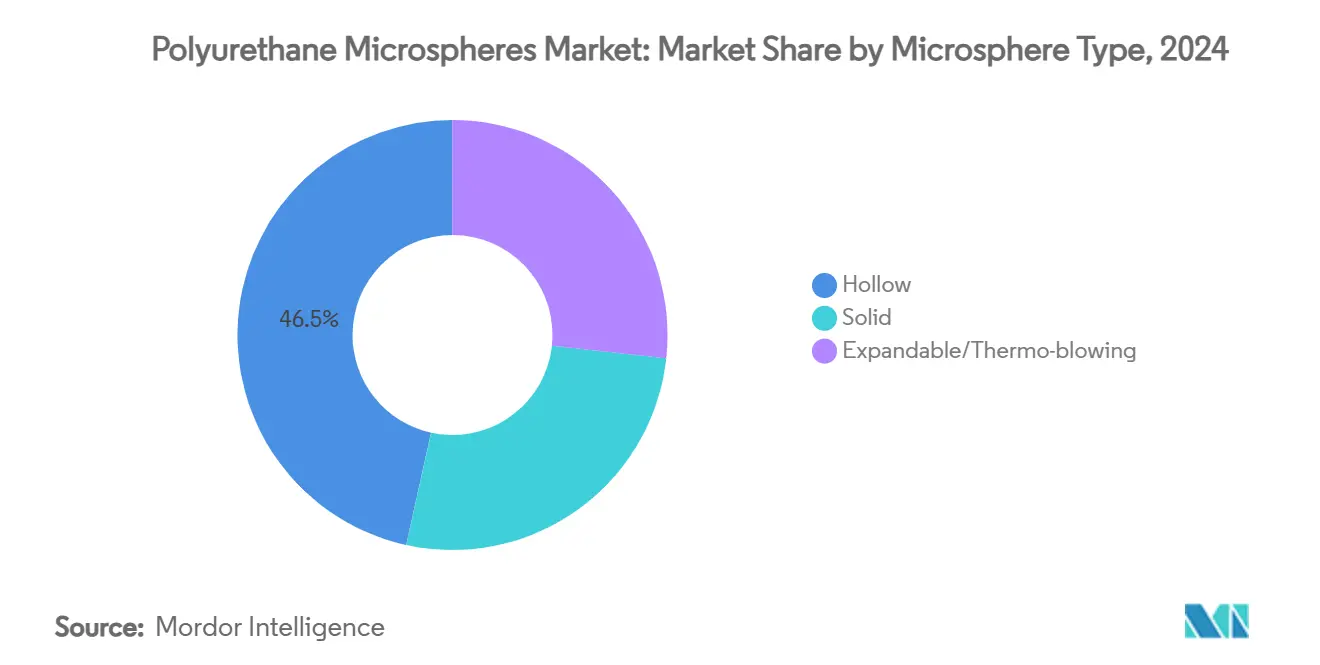
Note: Segment shares of all individual segments available upon report purchase
By Raw Material: Aromatic Dominance Faces Aliphatic Challenge
Aromatic systems held 60.45% of 2024 revenue, underpinned by cost-efficient MDI supply integrated into automotive and industrial coating chains. Yet aliphatic formulations are projected to outpace the overall polyurethane microspheres market at 5.17% CAGR because UV stability and non-yellowing traits appeal to premium outdoor coatings and luxury automotive topcoats.
Bio-based diisocyanates synthesized from D-galactose mark a turning point: they remove phosgene and lower carbon impact while matching aromatic reactivity. Meanwhile, CO₂-derived polyols can displace up to 30% fossil feedstock, providing cost hedges against crude swings and burnishing ESG scores.
By Application: Encapsulation Emerges as Growth Leader
Paints and coatings commanded 35.61% of polyurethane microspheres market size in 2024, benefiting from the ongoing shift toward lightweight fillers in automotive and architectural finishes. Durable shells withstand shear up to 350 bar, satisfying robotic spray booth demands.
In contrast, encapsulation is projected to clock a 4.98% CAGR to 2030, the quickest inside the polyurethane microspheres market, propelled by controlled-release drugs, fragrance textiles and agrochemicals that require tight payload protection. Adhesives for electronics and smart-textile coatings add incremental volume, whereas cosmetics leverage the silky tactile feel and optical blurring of microspheres to differentiate premium SKUs.
By End-Use Industry: Electronics Sector Accelerates Growth
Automotive applications held 28.82% revenue share in 2024; coatings, NVH foams and lightweight structural inserts anchor this lead. Yet electronics is predicted to grow at 5.24% CAGR, topping all sectors, as semiconductor packaging turns to microsphere fill for ESD suppression and low-κ dielectrics.
Flexible printed circuit boards integrate spheres to balance thermal and mechanical stresses, while wearable devices exploit porous morphologies for breathable sensor housings. Healthcare follows with expanding drug-delivery pipelines and minimally invasive device coatings that demand biocompatible carriers.
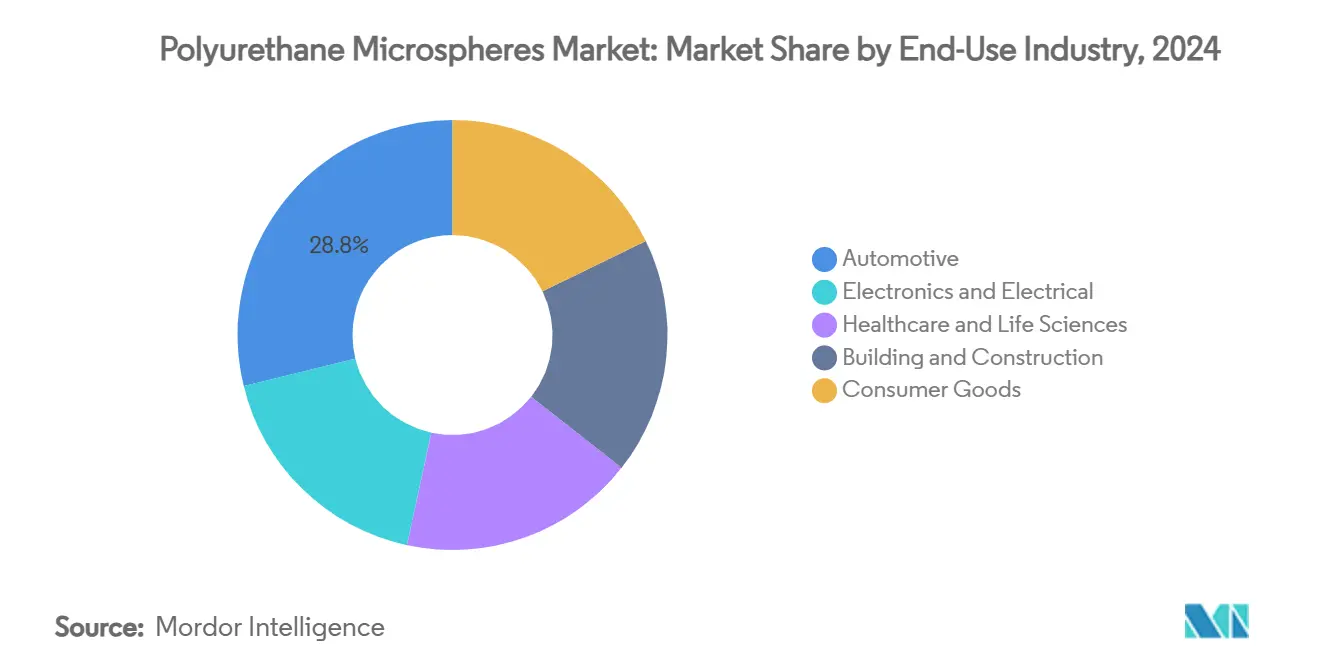
Note: Segment shares of all individual segments available upon report purchase
Geography Analysis
Asia-Pacific retained 45.62% of global volume in 2024 and is expected to chart the fastest 4.88% CAGR through 2030, confirming its central role in the polyurethane microspheres market. China concentrates feedstock and downstream converters in clusters such as Guangdong, trimming logistics costs and accelerating product customization cycles. India’s production-linked-incentive scheme for electronics keeps demand momentum strong, while Japanese firms leverage quality reputations to supply micro-encapsulation to leading pharma brands.
North America represents a technology-driven yet mature buyer base. U.S. automakers coated 142 million lb of vehicle surfaces with polyurethane chemistry in 2023, and OEM push for lighter EV architectures keeps the polyurethane microspheres market engaged[2]American Chemistry Council, “Automotive Coatings,” americanchemistry.com . Mexico’s ascent to the fourth-largest polyurethane consumer aligns with near-shoring trends that invite component suppliers to cluster around North-American final assembly hubs.
Europe wields global regulatory influence through REACH and proposed diisocyanate OELs, effectively setting safety baselines for the polyurethane microspheres industry worldwide[3]EUROPUR, “Commission Proposes OELs for Diisocyanates,” europur.org . German and Italian specialty chemical firms innovate in UV-curable and bio-based systems, while UK policies continue mirroring EU norms post-Brexit. South America plus Middle East & Africa trail in share but record double-digit import growth for construction and mining coatings that value the energy-saving profile of hollow spheres.
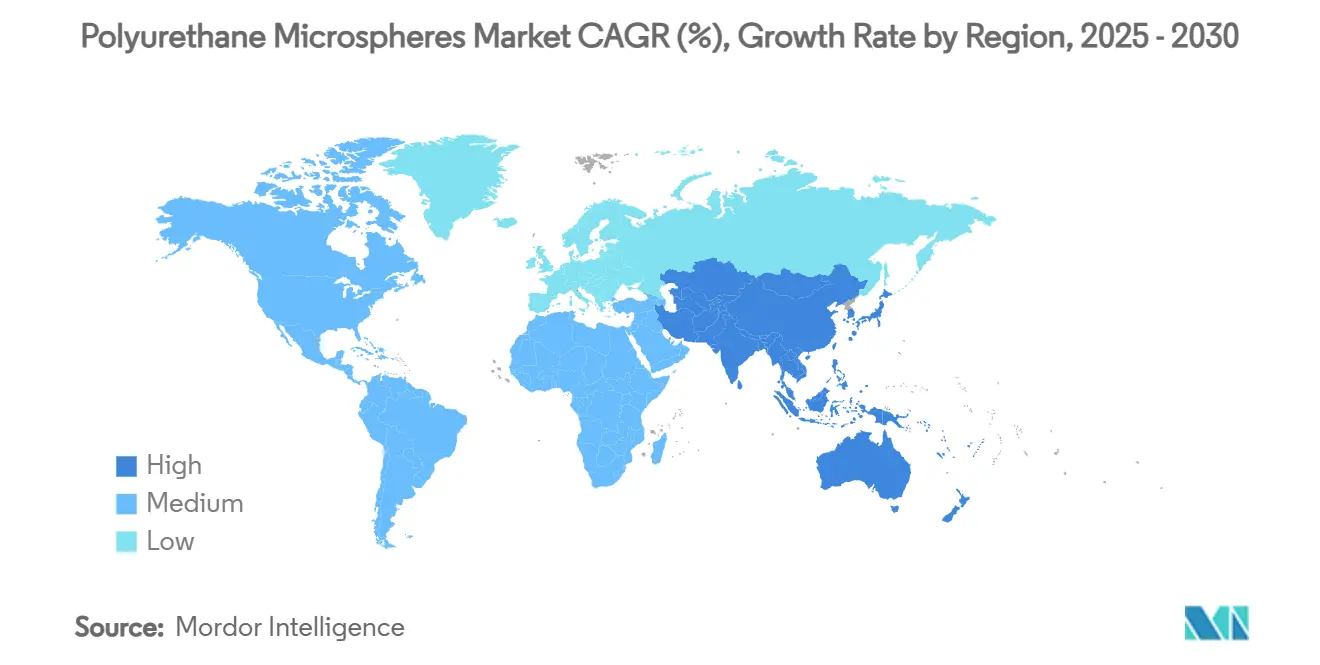
Competitive Landscape
The polyurethane microspheres market displays moderately fragmented concentartion. Chase Corporation generated USD 293.3 million in 2021, with its Adhesives, Sealants & Additives arm supplying aerospace and medical customers that demand tight particle-size controls. Covestro AG couples captive MDI/TDI manufacture with downstream dispersions, enabling cost leverage and rapid new-grade rollouts.
Strategic moves emphasize sustainability: Nouryon opened a Wisconsin Expancel line in 2023 to cut delivery lead-times for North American clients. HB Fuller is commercializing polyurethane polyols with up to 40% captured CO₂, underscoring carbon-reduction ambitions. Henkel’s micro-emission adhesive line addresses REACH compliance while preserving bond strength, offering a template for smaller players confronting regulatory barriers.
Patent filings on micro-encapsulation—such as US 3516941A—remain active, indicating white-space competition in shell chemistries and stimuli-responsive release systems. Acquisition appetite persists: Tosoh’s earlier buy-out of Nippon Polyurethane reflects long-term integration logic that could repeat as Asian producers chase economy-of-scale advantages. Overall, market rivalry hinges on R&D differentiation, regulatory fluency and supply security.
Polyurethane Microspheres Industry Leaders
-
Chase Corp.
-
HOS-Technik GmbH
-
Lamberti S.p.A.
-
SANYO CHEMICAL INDUSTRIES, LTD.
-
Nippon Kayaku Co.,Ltd.
- *Disclaimer: Major Players sorted in no particular order
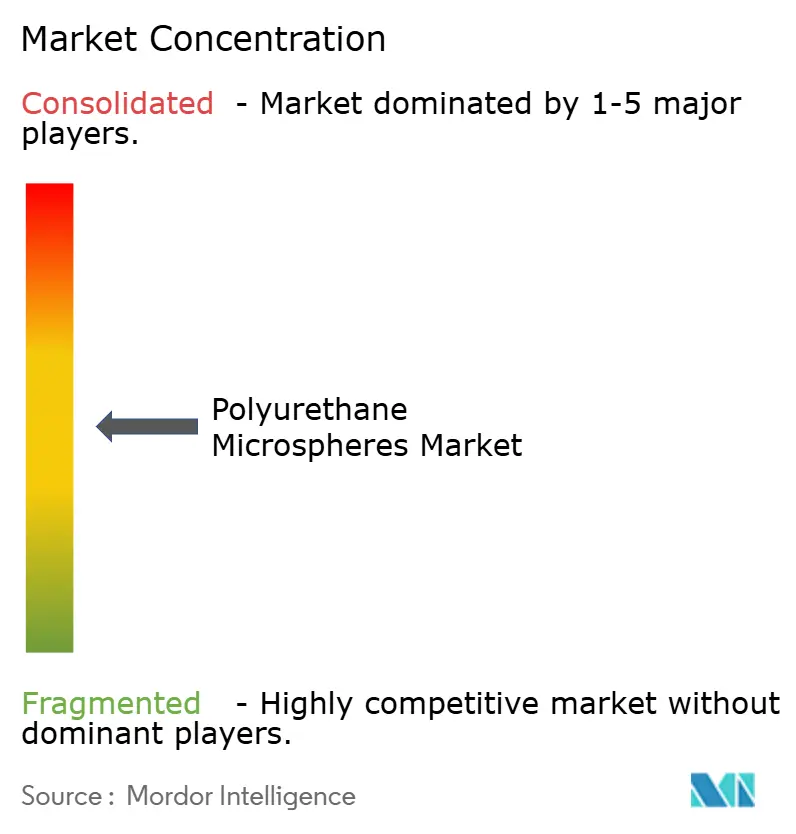


Recent Industry Developments
- December 2024: Nouryon launched Expancel BIO microspheres, the first generation of partially bio-based lightweight fillers and blowing agents, targeting sustainable construction and automotive applications. This innovation is set to drive growth in the polyurethane microsphere market by meeting the rising demand for eco-friendly solutions.
- October 2023: Nouryon commenced full-scale production at its Expancel expandable microspheres plant in Green Bay, Wisconsin, enhancing service capabilities for North American specialty-additives customers. This development is expected to drive the polyurethane microsphere market by improving product availability and meeting regional demand.
Global Polyurethane Microspheres Market Report Scope
The Polyurethane Microspheres Market report include:
| Solid |
| Hollow |
| Expandable/Thermo-blowing |
| Aromatic Polyurethane |
| Aliphatic Polyurethane |
| Encapsulation |
| Paints and Coatings |
| Adhesives |
| Cosmetics |
| Other Applications (Printing Inks, etc.) |
| Automotive |
| Electronics and Electrical |
| Healthcare and Life Sciences |
| Building and Construction |
| Consumer Goods |
| Asia-Pacific | China |
| Japan | |
| India | |
| South Korea | |
| ASEAN Countries | |
| Rest of Asia-Pacific | |
| North America | United States |
| Canada | |
| Mexico | |
| Europe | Germany |
| United Kingdom | |
| France | |
| Italy | |
| Spain | |
| Russia | |
| NORDIC Countries | |
| Rest of Europe | |
| South America | Brazil |
| Argentina | |
| Rest of South America | |
| Middle East and Africa | Saudi Arabia |
| South Africa | |
| Rest of Middle East and Africa |
| By Microsphere Type | Solid | |
| Hollow | ||
| Expandable/Thermo-blowing | ||
| By Raw Material | Aromatic Polyurethane | |
| Aliphatic Polyurethane | ||
| By Application | Encapsulation | |
| Paints and Coatings | ||
| Adhesives | ||
| Cosmetics | ||
| Other Applications (Printing Inks, etc.) | ||
| By End-use Industry | Automotive | |
| Electronics and Electrical | ||
| Healthcare and Life Sciences | ||
| Building and Construction | ||
| Consumer Goods | ||
| By Geography | Asia-Pacific | China |
| Japan | ||
| India | ||
| South Korea | ||
| ASEAN Countries | ||
| Rest of Asia-Pacific | ||
| North America | United States | |
| Canada | ||
| Mexico | ||
| Europe | Germany | |
| United Kingdom | ||
| France | ||
| Italy | ||
| Spain | ||
| Russia | ||
| NORDIC Countries | ||
| Rest of Europe | ||
| South America | Brazil | |
| Argentina | ||
| Rest of South America | ||
| Middle East and Africa | Saudi Arabia | |
| South Africa | ||
| Rest of Middle East and Africa | ||


Key Questions Answered in the Report
What is the current size of the polyurethane microspheres market?
The polyurethane microspheres market size reached USD 92.24 million in 2025 and is projected to climb to USD 116.16 million by 2030 at a 4.72% CAGR.
Which region leads global demand?
Asia-Pacific controls 45.62% of global revenue thanks to integrated supply chains and booming electronics and automotive output.
Which microsphere type holds the largest share?
Hollow microspheres dominate with 46.54% share because they deliver significant weight savings without compromising strength.
Which application area is growing the fastest?
Encapsulation—for pharmaceuticals, fragrances and agrochemicals—is forecast to grow at a 4.98% CAGR through 2030.
How are regulations affecting market development?
EU REACH rules mandating training for diisocyanate handling and impending occupational exposure limits are pushing manufacturers toward low-emission and bio-based formulations.
Page last updated on:
